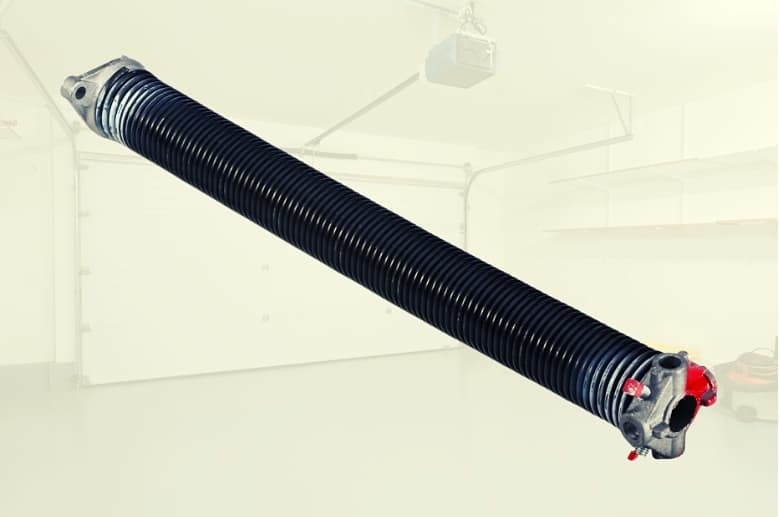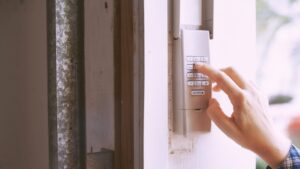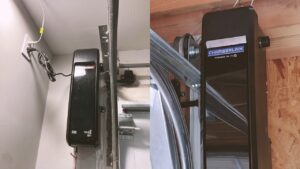Have you taken a glimpse at your garage door springs but weren’t quite sure what the color code meant? Don’t worry—you are not alone. Most homeowners don’t think about their garage door springs until something goes wrong.
Understanding your garage doors springs color code helps you identify your correct spring size and save you some money on service charges.
Moreover, finding your garage door springs damaged accidentally can be devastating. Luckily, this guide will help you identify the right size and color of spring for your garage door.
Ready to learn more? Let’s dive right in.
Which Springs Will Fit My Garage Door?
Understanding what types of garage door springs compatible with your door is crucial to comprehend the color code utilized for identifying its distinctive features. Selecting the wrong type and size of spring can cause problems with opening and closing the garage door, in addition to causing long-term wear and tear on its components.
Both torsion springs and extension springs use color-coded options when it comes to sizes, materials, and load ratings. This is because there are two different types of springs, each requiring different specifications to fit properly.
- Torsion Springs are wound in a coil shape and store energy as it is released when the garage door opens or closes.
- Extension springs, on the other hand, stretch and retract as the door moves up and down.
Hence, understanding their differences is essential in making sure your garage door runs smoothly every time.
Torsion Springs

Torsion springs are garage door springs that can be spotted above the door and look like large steel rods in two separate coils. They often have larger bends on each end. When broken, they split into two separate pieces, which makes them quite visible and easy to identify.
These springs are within an assembly inside the header, typically centered above the garage door. They use torque to increase lift power, pressing against drums that rotate when operated.
A garage door torsion spring chart can be used to determine the sizes and characteristics of those springs. The chart is color-coded to indicate the wire size, type of material, outside diameter (OD), inner diameter (ID), active coils, and various other factors.
For example, a torsion spring in orange may indicate an 18” length with a 2.25” inside diameter and 1.25” wire thickness. A blue torsion spring may indicate a 22” length with a 2.5” inside diameter and 0.243” wire thickness.
It is important to remember that not all manufacturers use the same color code. Therefore, it is best to double-check the door manually or call the manufacturer before buying and fitting new springs.
Torsion springs are favorable over other springs due to their increased lift capacity. They have improved dynamic performance in rough conditions, as they absorb grinding shocks and vibration better. As such, torsion springs provide reliable use for longer than other garage doors.
Extension Springs

Extension springs are a type of spring commonly used in garages and can be identified easily due to their distinctive look. They resemble a coil and have hooks on either end.
They are typically found along the length of the garage door and connected with pulleys. They work when a system tension is released, which contracts the spring resulting from an extension of those coils, creating energy.
You can use a garage door extension spring size chart to determine the characteristics of the springs. Extension springs use a color code system similar to torsion springs, though they may differ from manufacturer to manufacturer.
For instance, an extension spring in black may indicate a 19” length with two coils and 0.1875” wire thickness.
Compared to other types of springs, extension springs offer multiple advantages, such as being cost-effective and providing more power, allowing heavier objects to be lifted.
Additionally, they offer greater safety since they have fewer rotating parts than torsion springs, thus preventing accidents related to excessive tension on cables.
Knowing how to recognize this type of spring will help ensure your garage door works properly.
Connect With A Garage Expert
Connect with local experts, Compare quotes, Get the best price.
What Does the Color Code Mean on Garage Door Springs
Understanding the different colors of garage door springs can be helpful when it comes to choosing the right kind of spring for your needs.
Certain colors often mean that the springs are better suited to handle larger or heavier doors, making them extra durable and less likely to break prematurely.
Yellow-colored springs typically hold doors up to 125 pounds, while blue-colored ones are designed for a slightly heavier door weight of up to 150 pounds.
Additionally, red-colored springs support even bigger, heavier doors weighing up to 175 pounds.
Knowing the color code and what it indicates is important when installing garage door springs for your particular situation.
Color Codes System for Torsion Springs
Color codes system for torsion springs is an effective way to keep track of the various components involved in their production. This system assigns a specific code or color to each piece of the torsion spring, making labeling and sorting easier.
In addition to simplifying tracking they also help manufacturers identify patterns between their different products.
Each spring assigned a unique color based on characteristics such as length, diameter, and coil count, making the process of identifying performance levels intuitive and efficient.
With this system, companies can quickly know the specifications for any order, allowing them to provide the best possible product to their customers.
How Do I Know What Torsion Spring I Need for My Garage Door?
When selecting the right torsion spring for your garage door, it is important to consider the size and weight of your garage door. Start by measuring the height and weight of your garage door, then use the spring color code chart to determine the appropriate torsion spring size.
The DASMA garage door spring size chart below will provide you valuable information about the type of torsion spring required to safely lift and securely support your door, as well as its expected lifespan.
| Colors | Inches | Millimeters |
| Orange | .120/.192/.273/.363/.485 | 3.00/4.20/6.25/8.00/11.10 |
| Light Blue | .125/.200/.283/.375/.4900 | xx/4.50/6.40/8.10/11.50 |
| Yellow | .135/.207/.289/.394/.500 | 3.20/4.60/6.50/8.40/11.70 |
| White | .139/.218/.295/.406/.531 | xx/4.70/6.80/8.80/12.00 |
| Red | .143/.225/.297/.422/.563 | 3.40/4.80/7.00/9.20/12.30 |
| Brown | .148/.234/.307/.431/.625 | xx/5.00/7.30/9.60/13.00 |
| Tan | .156/.238/.313/.438 | 3.50/5.25/7.35/10.00 |
| Green | .162/.244/.319/.453 | 3.60/5.50/7.50/10.50 |
| Gold | .177/.250/.331/.462 | xx/5.75/7.60/10.70 |
| Purple | .182/.257/.594 | 3.80/6.00/12.50 |
| Blue | .188/.263/.344/.469 | 4.00/6.05/7.80/11.00 |
Color Codes system for Extension Springs
An efficient way to identify the sizes and characteristics of extension springs is through the use of spring color codes. Many companies use it to identify the Spring sizes and characteristics to help ensure they purchase the right kind of spring.
While some companies rely on color coding to differentiate types, others will pair a numerical code with a color code, which can provide even more information about the spring than just from its color alone.
Overall, the widespread use of color coding for Extension Springs has made it easy to ensure that the correct springs are obtained for any project.
Connect With A Garage Expert
Connect with local experts, Compare quotes, Get the best price.
How Do I Know What Extension Spring I Need for My Garage Door?
To figure out garage door extension spring color codes for your garage door, it is essential to identify the measurements and type of your existing spring. Knowing this information will help you identify the correct spring size for your garage door.
Additionally, the color of the springs can indicate their length and strength. Here’s a handy chart that outlines the various colors used with their corresponding lengths and strengths according to the standard DASMA garage door spring size chart.
Armed with this knowledge, you may be able to purchas your garage door’s springs on your own, without the assistance of a professional.
| Color | Pounds | Kilograms |
| White | 10/110/210 | 5/50/95 |
| Green | 20/120/220 | 10/55/100 |
| Yellow | 30/130/230 | 15/60/105 |
| Blue | 40/140/240 | 20/65/110 |
| Red | 50/150/250 | 25/70/115 |
| Brown | 60/160/260 | xxx |
| Orange | 70/170/270 | 30/75/120 |
| Gold | 80/180/280 | 35/80/125 |
| Light Blue | 90/190/290 | 40/85/130 |
| Tan | 100/200/300 | 45/90/135 |
| White | 10/110/210 | 5/50/95 |
Conclusion
Regardless of the type of springs you have, the color code will tell you if they are designed to be installed where you want to install them or not.
By understanding the colors of garage door springs and performing regular maintenance on them, you can avoid having an emergency repair when they break.
If you need assistance regarding garage doors springs color codes, this guide has you covered. But you can always schedule a call with our professionals, who are ready to help you!




